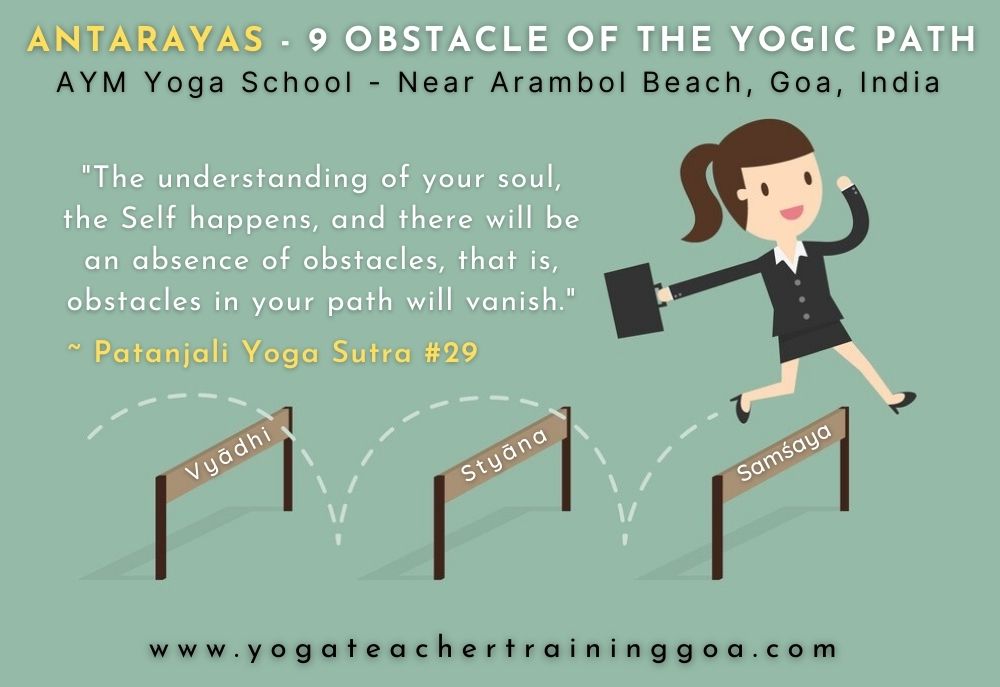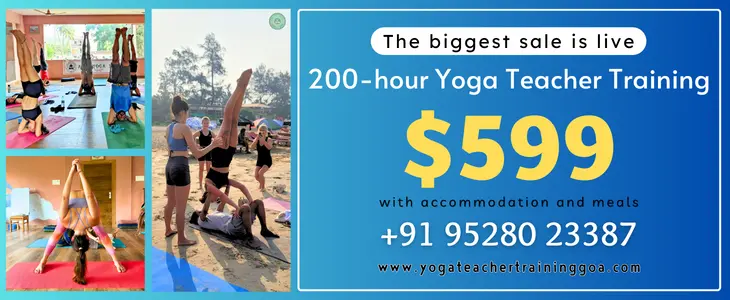
Antarayas – the 9 obstacles on the yoga path
Antarayas the obstacles: In Yoga Sutra I, 30 Patanjali writes: “vyadhi styana samsaya pramada alasya avirati bhrantidarsana alabdhabhumikatva anvasthitatvani citta viksepas te` ntarayah.”
Antarayas the obstacles: Patanjali lists nine obstacles (Antarayas) that arise from distractions in the mind. These can prevent us from practising yoga or a liberated life. I don’t necessarily see obstacles as irrevocably preventing us from doing something; instead, it is something that we want to overcome to reach our goals with enormous strength. In this respect, obstacles are valuable pointers that show us how to develop our most significant potential. Trying to avoid them is wrong because that only reinforces them. We can gratefully accept them and transform them into wonder.
Antarayas the obstacles
These are the nine obstacles, according to Patanjali, commented by me:
1. Vyadhi – Disease:
Illness prevents us from fully living life and from deepening our yoga practice. However, illness indicates that one should work on important things before proceeding. Every illness can be a real g guru and help us shed light on hidden blockages. If we try to feel the illness without resistance, it can convey something enlightening and learn a great deal.
Every physical symptom has its cause in the soul and spirit. Because it manifests itself in the physical, the problem is already quite advanced. Still, on the other hand, it allows effortless access via the physical to find a way to resolve it. But karma also plays a vital role concerning illness. If we don’t take care of our body and put substances that harm it, it will damage it. Here, the constitution and the state of mind also weaken or strengthen.
I do not see that sickness from the practice is generally discouraged because they already have employment and thus can be very yogic. It prevents us from doing some yoga practices that we can only do if we are healthy. But here, I would like to emphasize the journey is the goal, and it is essential to deal with it. So, one can practice healing yoga in any state, even if it is only mental. In Hatha Yoga, one strives to take precautions not to let the diseases manifest themselves in the first place. In any case, this gives you more significant potential to practice and accelerate development.
2. Styana – Mental lethargy, exhaustion:
Styana doesn’t let us be there. It’s tiredness that makes it difficult to experience the present. It can keep us from living and practising yoga and dull us if we are not careful. Also, at the end of the Mahabharata, fatigue is mentioned as the most significant obstacle in life. Buddhism also refers to Styana as one of the five obstacles.
It is worth finding out what causes this fatigue. The possibilities of the causes are numerous and often a combination:
– Too little restful, deep sleep
- psychological causes
- Blockages in the pranayama kosa
- Wrong diet
- Food (drugs) and environmental toxins
- Bombardment by technical radiation
- Geomantic earth radiations
- Energy vampirism
- Voluntary energy donation
- anxiety
And a lot more.
I discuss possible solutions in my essay on “Spiritual Grounding.”
3. Samsaya – Doubt:
Doubt is a major obstacle as it reinforces thinking, too. The main reason for doubt is great uncertainty and the fear of doing or believing the wrong thing. It is often a fear of not being on the right path, i.e., fulfilling one’s particular Dharma. The cause is then a lack of discernment, Viveka. To be involved in the Yoga path, you need at least a minimal ability to differentiate between good and reasonable. It would be best to decide to follow the path and not be too easily distracted. Yoga brings us more and more into our canter and gives us access to our intuition to know what we want.
Through this experience, we then also know how we can overcome all doubts: through sensing, experiencing, connecting with higher levels, and following the feeling of love and peace. Doubts are a cry for help from our soul to reconnect with it. Since they come purely from our minds, which often don’t know what is good for us. The point is to detach ourselves from the mind through meditation, not to let it control us. This is the most important task we have in doubtful moments. Getting too involved in our doubts can wear us down, close our hearts, and prevent us from moving forward. However, doubts can be very useful if we do not take everything to make our constructive thoughts.
4. Pramada – Carelessness:
Meditation is mindfulness. Mindfulness is the way into deep spirituality; inattention lets us fall back or get lost. Most of the time, life immediately gives us a clue of the carelessness we’ve just committed, for instance, by bumping into something, dropping something, or having a negative feeling due to an inattentive action that occurs immediately. The cause lies in not-quite-there-not being in present and disinterest that considers something other. Carelessness can only arise when we are not present here and now.
5. Alasya – Indolence, laziness:
When tamas-guna (the energy of idleness) prevails, it often shows itself in laziness. Laziness keeps us from doing everything good for us and lets us waste away in a certain way. We then feel burdensome, and this heaviness spreads to everything, making everything too heavy and strenuous. It can be dangerous to throw our lives away and draw ourselves into unconsciousness.
It requires a specific ability to differentiate whether tamas-guna or sattva-guna prevails in our desire for relaxation. Peace is often essential, but true relaxation refreshes us afterwards. Suppose you allow yourself to be deterred from yoga practice by indolence. In that case, this is a sign of unhealthy passivity, and there should be a warning about it because there are always very relaxed yoga practices, such as deep relaxation, which meet our need for rest.
6. Avirati – Attachment to worldly things:
If we let ourselves be influenced by worldly things and sensual pleasures and lose our hold, it distracts us. We are no longer ourselves, only reacting to external influences, and can be easily manipulated. In that case, this keeps us from our yoga practice and recognizes the only authentic, immortal. But if we use worldly things and enjoy their impermanence, we fulfil their and our reason for existence.
7. Bhrantidarshana – Delusion:
Deception can occur through wrong sensory perception, understanding, and imagination. Above all, I see the danger of a subjectivity that looks at everything from its imperfect point of view, strongly influenced by our imprints and the mind. So, it is essential to always strive for a higher, more objective, superordinate perspective and not be fooled by illusions. It is essential not to take one’s ego so seriously and strive for the absolute truth. As Taimni also emphasizes, not to regard small enlightenment experiences as great ones is crucial. Many people consider themselves enlightened and have recognized part of the great truth on one level.
8. Alabdabhumikatva – The inability to gain solid ground under one’s feet:
Progress needs to be well-grounded; keep your concentration bit by bit. Yoga practice can give us a good hold. It is important not to lose sight of reality (the objective situation of the moment). If we fully perceive ourselves at the level where we are, with all good and evil, we can develop optimally from where we are without losing the eternal moment. This requires an acceptance of the present reality as it is. The physical exercises of Hatha Yoga support “staying on the ground” by dealing with the physical body.
9. Anavasthitatvani – Impermanence:
Losing concentration leads to instability.
It can quickly slip away if we are not focused enough on one thing. It also requires distinguishing which items are significant to me and which are not. I cannot handle everything well but must select the best one. In my experience, an obstacle of discontinuity disappears when you find what fills you to the depths of your soul.
I see the following instability in my yoga practice: I often lose yoga energy again very quickly. I lack perseverance or motivation because I could spend my whole life doing yoga. But my challenge is keeping the energy, relaxation, and joy I have gained daily. So, the problem lies in the inconstancy of my concentration and mindfulness, i.e., in the very sketchy awareness.
Conclusion:
In conclusion, I would like to say that, in my opinion, all obstacles only need two solutions: awareness and discernment. So, if we limit ourselves to developing these two traits, it will solve all our problems. Yoga leads to awareness, and Patanjali has developed the yoga path, Ashtanga yoga-marga, to strengthen the ability to differentiate (Viveka). Understanding leads to discernment, so this awareness is what we have to focus on. In Yoga Sutra I, 32, Patanjali also describes this: “that practised Northam ekatattva abhyanga,” Taimni translates:” To remove these obstacles, a truth or a principle should be constantly practised.

